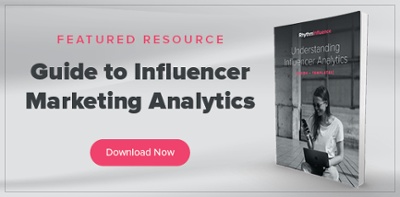Influencer marketing has grown exponentially in the past year and continues to rise with the growth of social media platforms like TikTok. As influencer marketing strategists, we have experience keeping up with a quickly evolving landscape of social content. With leagues of fresh faced Influencers entering the conversation seemingly every day, there are opportunities for brands to form lasting partnerships with new content creators .
While looking to the past is a key part of influencer marketing strategy, in a world that moves at the speed of the internet there is only so much that ruminating on past trends can do for your upcoming campaigns. So, where is influencer marketing headed?
What will influencer marketing look like in 2022?
Eighteen months ago influencer marketing strategists were presented with a challenge. Overnight we had to adapt to suddenly marketing to a world of people who couldn’t leave their homes. Entire content calendars were thrown out the window and replaced with relevant new ones that more accurately reflected the state of the world. The past year and a half was filled with producing content that spoke to the social issues plaguing our country, brand after brand adding their unique voice to the conversation as we struggled alongside one another from a safe distance.
Now, as the world begins to open back up and starts to resemble a pre-pandemic world that we recognize, brands are faced with a new set of challenges. The same uncertainty that dominated our lives at the beginning of 2020 is still prevalent today, the obstacles just have new faces and names. It is the responsibility of brands to use their influencer marketing strategy to continue to allow for connections as bits of normalcy return.
Let’s take a look at the top influencer marketing statistics to gain an understanding of the current state of the influencer marketing industry.
Top 5 Influencer Marketing Statistics to Know
- 72.5% of marketers say that they plan to increase their influencer marketing budgets in 2022.
- Between 2021 and 2023 brands will spend an increase of 25% on influencer marketing, growing the projected industry worth total to $4.62.
- The influencer industry itself is expanding rapidly as well, with 86% of young people choosing becoming an Influencer as their ideal career.
- 61% of consumers say that they trust an Influencer’s brand, product, and service recommendations.
- 97% of marketers consider Instagram the most important influencer marketing channel, but TikTok has the highest engagement out of any platform with micro-influencers generating a whopping 17.96% engagement rate.
Influencer Marketing Trends to Look Out For in 2022
The influencer marketing industry is growing and is projected to continue that growth for years to come. Marketing strategists will need to be proactive in 2022, leaving room in the content calendar for timely campaigns and in-the-moment partnerships with new, or trending creators.
Here are influencer marketing trends and predictions for the coming year.
1) Data and analytics will drive influencer marketing strategy.
Content performance metrics have long had a place in influencer marketing. At this point, each social media platform comes with built-in metrics that anyone can use to monitor the engagement and reach of their posts. And while these metrics have long existed as a way to determine the success of the content and even entire campaigns, as the influencer marketing industry continues to expand and more brands begin using performance-based contracts with their influencer partners then big data will start to play a bigger role in more marketing strategies.
As the industry continues to pick up steam and both brands and Influencers are perfecting their crafts, individual campaigns hold more weight than they ever did before. Subsequently, strategists are leaning heavily on hard data and campaign analytics to drive their upcoming marketing strategies. Campaigns have the potential to provide traffic and engagement long after the activation ends. Companies will begin to measure the long-term impact of influencer campaign ROI, showing even more clearly how valuable influencer partnerships are to growing brands.
2) Video content will grow in prominence.
Video content is one facet of the influencer marketing world that has boomed in recent years. Due in large part to the introduction and rapid growth of TikTok, Instagram Reels, and YouTube Shorts, all short-form video content, as well as a platform-wide embrace of live video features, video content is picking up steam and is showing no signs of slowing. It is estimated that by 2022, 1 million social media videos will be watched per second.
This growth is not unprecedented when you consider the increased familiarity that video content provides brands with. A photo can show a consumer a glimpse into the life of an Influencer using a brand’s products, but a video can tell an entire story. And at a time where Influencers are rewarded for making a genuine connection with their audiences (more on that in a bit) anything brands can do to show off even a little bit more of the lives of their Influencer partners takes them a step ahead of the competition.
3) Influencer and brand authenticity will continue to be rewarded.
In the modern world, people care more about the brands they use than ever before. It is no longer enough for a brand to sell a good or even great product. Instead, brands need to have a clear and unique voice, an active opinion of a variety of current social issues and sell a good or great product.
Companies aren’t looking to simply attract and convert prospects or followers into customers, but to turn customers into brand and product ambassadors, and loyal lifetime brand advocates.
As we move into the future and whatever new social and political issues it may bring with it, brand partnerships need to be authentic to have an impact. Brands unwilling to use their voice to share their views will be overlooked for more vocal brands. Similarly, inauthentic Influencers will lose relevancy and be unable to connect with their audiences. On social media, authenticity, and natural, genuine behavior is rewarded. Audiences appreciate it when they feel respected by the Influencers they spend their time observing, not pandered to. To continue making an impact, brands and Influencers must partner up for the greater good.
For inspiration on your next campaign, here are How Celebrities are Pairing with Brands for the Greater Good.
4) New social media platforms and forms of content will begin to emerge.
If there is one thing that is absolutely certain about influencer marketing it’s that it is ever-changing. Again, it’s important to mention that TikTok had an unprecedented year, maintaining over 689 million global active users since January 2021— a landmark that becomes even more impressive when you remember that TikTok was only released in 2016.
Additionally, last year the world was also introduced to Clubhouse, the audio-based invite-only social media platform that developed its own internal influencer program. Any time a fresh and unique social media platform with promise hits the app store, it’s only a matter of time before Influencers start flocking to it.
Content is also consistently undergoing changes as well. As mentioned, video appears to be the new frontier of influencer marketing. However, virtual reality and artificial intelligence are also beginning to emerge as key components of successful influencer marketing campaigns. Some brands have even begun partnering with CGI Influencers— which in a pre-social media world would be called robots— in an effort to bring their campaigns into the future.
The key here isn’t to always be the first to make a mark on a new platform or with a new form of content but to simply remain aware of the changes like these that are shaping the influencer marketing industry. Then, when the time comes you’ll be prepared to seamlessly integrate these new components into your next big campaign.
5) Influencer marketing will only become more and more niche.
Every brand is a part of a specific industry. Likewise, every Influencer is a member of a specific community. Some of these communities are large and have a dominant presence across multiple platforms— such as health and wellness, lifestyle, or fashion— whereas other online communities are much smaller and more niche— like cottagecore or vegan parents who homeschool their kids. No matter their size, every online community is led by one Influencer or another. And typically, the more niche an online community is, the more powerful the Influencers of that community are.
Alongside this trend is the ongoing fact that nano and micro-influencers see higher engagement than their mega and celebrity influencer tier peers. Micro-influencers have the highest engagement rates when compared to their more heavily followed peers, with 3.86% engagement on Instagram and as much as 17.96% on TikTok. Finding the right Influencer to partner with on a campaign requires a strong strategy and finding the right person whose strengths match your campaign goals.
The best way to improve influencer marketing efforts is testing and optimization. Learn more in the Guide to Influencer Marketing Analytics.




SUBMIT YOUR COMMENT